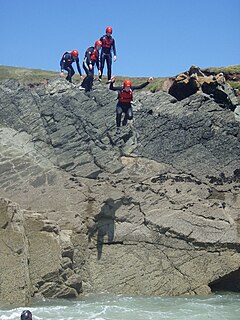 W
WDiving is the sport of jumping or falling into water from a platform or springboard, usually while performing acrobatics. Diving is an internationally recognized sport that is part of the Olympic Games. In addition, unstructured and non-competitive diving is a recreational pastime.
 W
WA Cannonball, also referred to as a Bomb, is a diving style where the diver hugs their knees and attempts to enter the water with their body shaped as much like a sphere as possible. The goal is to create a large splash.
 W
WCliff jumping is jumping off a cliff as a form of sport. When done without equipment, it may be also known as tombstoning. It forms part of the sport of coastal exploration or "coasteering". When performed with a parachute, it is known as BASE jumping. The world record for cliff jumping is currently held by Laso Schaller, with a jump of 58.8 m (193 ft).
 W
WHigh diving is the act of diving into water from relatively great heights. High diving can be performed as an adventure sport, as a performance stunt, or competitively during sporting events.
 W
WA diving platform or diving tower is a type of structure used for competitive diving. It consists of a vertical rigid "tower" with one or more horizontal platforms extending out over a deep pool of water. In platform diving, the diver jumps from a high stationary surface. The height of the platforms – 10 metres (33 ft), 7.5 metres (25 ft) and 5 metres (16 ft) – gives the diver enough time to perform the acrobatic movements of a particular dive. There are additional platforms set at 3 metres (9.8 ft) and 1 metre (3.3 ft). Diving platforms for FINA sanctioned meets must be at least 6 metres (20 ft) long and 2 metres (6.6 ft) wide. Most platforms are covered by some sort of matting or non-slip surface to prevent athletes from slipping.
 W
WThe plunge for distance is a diving event that enjoyed its greatest popularity in the 19th and early part of the 20th century, even being included as an official event in the 1904 Summer Olympics. By the 1920s, it began to lose its popularity and slowly disappeared from U.S. and English swim competitions.
 W
WA springboard or diving board is used for diving and is a board that is itself a spring, i.e. a linear flex-spring, of the cantilever type.